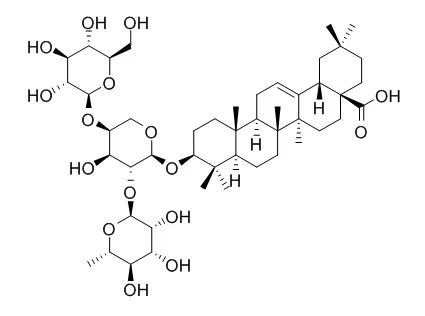| Carbohydr Res. 2017 Apr 10;442:9-16. |
| Synthesis and cytotoxicity of oleanolic acid trisaccharide saponins.[Pubmed: 28273565] |
METHODS AND RESULTS:
An array of oleanolic acid-type saponins based on β-hederin has been synthesized in a linear or one-pot manner. The cell viability assays indicate that synthetic saponins show antiproliferation activities in three cancer cell lines with IC50 values of 2.4-15.1 μM and Hederacolchiside A1 being the most potent. The results demonstrate that the type of terminal monosaccharides and linkage position have apparent effects on cytotoxicities and selectivities of these saponins against cancer cell lines tested.
CONCLUSIONS:
This study is helpful for future development of more potent anticancer leads. |
| Cancer Chemother Pharmacol. 2004 Nov;54(5):432-40. |
| Inhibition of HUVEC tubulogenesis by hederacolchiside-A1 is associated with plasma membrane cholesterol sequestration and activation of the Ha-Ras/MEK/ERK cascade.[Pubmed: 15490165] |
Neoangiogenesis is critical to cancer proliferation and metastasis and constitutes an attractive target for cancer therapy. It has previously been demonstrated that hederacolchiside-A1 (HCol-A1), a triterpenoid saponin from Hedera colchica Koch, has antimelanoma potential. The goal of this study was to evaluate, in vitro, if in addition to its tumoricidal effect on melanoma cells, HCol-A1 might affect endothelial cell network formation.
METHODS AND RESULTS:
We investigated whether HCol-A1 affects matrigel-induced tubulogenesis and inhibits the viability (WST-1 assay) of human umbilical vein endothelial cells (HUVECs). To provide structure-activity relationships (SAR), studies were conducted on HCol-A1, oleanolic acid and hederacolchiside A (HCol-A), a triterpenoid saponin which possess the same sugar sequence as Hcol-A1. Plasma membrane cholesterol sequestration was studied by labelling with [3H]cholesterol and assayed with HCol-A1-cholesterol complexes. HCol-A1 signalling was investigated using immunoassays.
In contrast to HCol-A and oleanolic acid, HCol-A1 inhibited matrigel-induced angiogenesis at micromolar concentration. Plasma membrane cholesterol sequestration was found to be critical for this activity. Activation of the Ras/MEK/ERK cascade appears to be one of the mechanisms by which Hcol-A1 affects HUVEC network formation. The predominant activation of the Ha-Ras isoform, which decreases HUVEC-tolerance to apoptosis, might contribute to the high susceptibility of this cell line to HCol-A1.
CONCLUSIONS:
Since cholesterol sequestration affects cell confluence-dependent remodelling of endothelial membranes and vascular endothelial growth factor receptor-2 activity, these results raise the possibility that Hcol-A1 might slow-down cancer proliferation and metastasis in vivo by inhibiting critical aspects of neoangiogenesis. Further in vivo studies are needed to verify this hypothesis. |
| Planta Med. 2000 May;66(4):343-7. |
| Antileishmanial activity of three saponins isolated from ivy, alpha-hederin, beta-hederin and hederacolchiside A1, as compared to their action on mammalian cells cultured in vitro.[Pubmed: 10865451] |
The in vitro antileishmanial activity of three saponins isolated from ivy, alpha-hederin, beta-hederin and Hederacolchiside A1, was investigated on Leishmania infantum.
METHODS AND RESULTS:
The assessment of possible targets (membrane integrity, membrane potential, DNA synthesis and protein content) was performed in both Leishmania promastigotes and human monocytes (THP1 cells). Results observed in Leishmania showed that the saponins exhibited a strong antiproliferative activity on all stages of development of the parasite by altering membrane integrity and potential: Hederacolchiside A1 appeared to be the most active compound against both promastigotes and amastigotes. Results observed in THP1 cells demonstrated that the saponins exerted also a potent antiproliferative activity against human monocytes, by producing a significant DNA synthesis inhibition.
CONCLUSIONS:
The ratio between antileishmanial activity on amastigotes and toxicity to human cells suggested that the saponins could be considered as possible antileishmanial drugs. |






 Cell. 2018 Jan 11;172(1-2):249-261.e12. doi: 10.1016/j.cell.2017.12.019.IF=36.216(2019)
Cell. 2018 Jan 11;172(1-2):249-261.e12. doi: 10.1016/j.cell.2017.12.019.IF=36.216(2019) Cell Metab. 2020 Mar 3;31(3):534-548.e5. doi: 10.1016/j.cmet.2020.01.002.IF=22.415(2019)
Cell Metab. 2020 Mar 3;31(3):534-548.e5. doi: 10.1016/j.cmet.2020.01.002.IF=22.415(2019) Mol Cell. 2017 Nov 16;68(4):673-685.e6. doi: 10.1016/j.molcel.2017.10.022.IF=14.548(2019)
Mol Cell. 2017 Nov 16;68(4):673-685.e6. doi: 10.1016/j.molcel.2017.10.022.IF=14.548(2019)